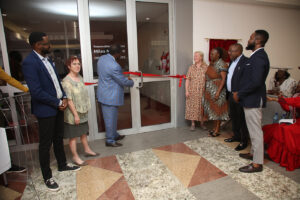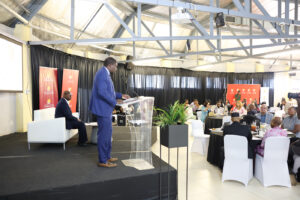An analysis of UNAM’s restructuring
As a proud alumnus of the University of Namibia’s Department of Political and Administrative Studies. I thought it is necessary to take a closer look at the grand changes I heard are happening at my alma- mater. Though I graduated well over eight years ago, I eagerly follow the affairs of my institution. Now, let me turn to the subject at hand.
Public funding for higher education has been in steep decline across the world for well over a decade now. When we look at Namibia, the same can be said for public funded institutions like the University of Namibia (UNAM) and the Namibia University of Science and Technology (NUST). Though the decline is more recent, it should be cause for concern for both the University staff and students that study there.
Indeed, publicly funded institutions have no choice but to respond to the changing external environment. UNAM has sought to respond to the reality of declining government funds, going as far back as 2015, when it went through a restructuring exercise, under the stewardship of Professor Lazarus Hangula- UNAM’s second Vice Chancellor.
I understand, upon taking the reins in late 2018, UNAM’s third Vice Chancellor, Professor Kenneth Matengu, initiated a revision of the 2015 restructuring exercise with the intention of thinning the University’s expanded top structure, and opted to improve efficiencies by merging faculties, directorates and related units, and has mooted increasing the university’s own income generation through grants, research, innovation and development.
Unlike the restructuring of 2015, which according to my assessment largely reviewed policies and re-defined some existing positions, the latest restructuring carries more radical changes such as redefining business processes, with the intention of making the university lean, agile and sustainable.
A key change for example is the reduction in the number of faculties, from eight (8) to four (4). Whereas historically deans headed faculties, a marked difference is the introduction of executive deans who will as of June 2021 head the four (4) new faculties. These new faculties appear to be a merger of complimentary existing faculties and schools. This means these executive deans will have more power, and authority to direct their respective faculties as sustainable components of the university. It is a longstanding practice in academia, to see disciplinary convergence in training with the intention to offer students a more varied education through more options by combining related and interrelated disciplines in similar faculties.
Here, the previous paradigm, of faculties operating as enclaves, separated students in their respective disciplinary silos. The former in catching up to practice internationally, opens up space for cross-disciplinary qualifications as is the normal elsewhere. Indeed, the world is moving towards the convergence of knowledge rather than narrow specialisation.
Fiscally, this alteration means that executive deans will not only supervise academic matters as is the standard norm, but will also be expected to meet demands of a revenue generation, human capital management; oversee the student experience and drive a robust research and innovation agenda.
Understandably, change and its content will spark debate especially within an environment in which debate is the primary mode of intercourse. It is understandable that reacting to the change, some academics may observe that changes appear to portend a “corporatisation of higher education”.
There is indeed a global debate in academia with two opposing poles; regarding this question. One opines that universities operating as businesses was an inevitable change, the other insists that universities need only concern themselves with producing knowledge and wisdom in a manner that is consistent with the traditions of academia.
Rebecca Clay (2008), ten years ago, showed cause by arguing that the rise of consumerism, and the increasing demand for accountability amid declining public funding for universities are the contributing factors as to why colleges and universities are adopting corporate models, cutting costs and focusing more on the bottom line than ever before. In its extreme form, the corporatisation of academia generally means that students are seen as “customers”, Vice Chancellors become “CEOs” and University Bursars “CFOs”. It involves teaming up with corporations to sponsor coursers and labs that carry their name and in turn help universities reach the market place.
While the change at UNAM is being driven by similar imperatives, as those occurring internationally for over the decade, UNAM’s restructuring appears to lean much closer to the classic model of universities, with only minute adjustment reflecting traces of corporatisation. Perhaps one such facet is the drive towards demand for increased accountability from staff and incoming executive deans. This is relevant as it comes on the cusp of perceptions by student organisations and the public of wastage of resources in universities. The best way to respond is through more precise accounting of resources.
The second distinction with UNAM, is that it has moved to separate the academic objectives from the more commercial activities through the creation of Inceptus Holding (Pty Ltd), a standalone business enterprise wholly owned by UNAM –dedicated to leading the university’s commercialisation activities.
In conclusion, because the University remains dependent on government as the largest funder of higher education, UNAM can therefore, not reasonably be held up as a case of “corporatisation of higher education” as is the case in other parts of the world. Additionally, as anyone who is aware of fee structures in the region may attest Namibian student fees still stack up well in terms affordability in Southern Africa, and are among the lowest. Meanwhile, the quality of higher education offered is comparable with the top 50 Universities on the continent. These facts bode well for the argument that higher education has not yet become a commodity in Namibia.
Though too early to assess, it may be safe to suggest that the current UNAM restructuring exercise, granted that it has not disadvantaged those at the forefront of teaching and learning, may be a logical reaction to changes in the external environment, and the next best shot, at the University remaining sustainable, viable and resilient for the coming years.
Edison Nengola studied Politics, and is a UNAM Alumnus from the Faculty of Economic and Management Sciences. He writes in his own capacity. Views expressed here are not necessarily those of the University of Namibia.





